
Kadena Air Base is a United States Air Force base in the towns of Kadena and Chatan and the city of Okinawa, in Okinawa Prefecture, Japan. It is often referred to as the "Keystone of the Pacific" because of its highly strategic location. It is located 650 km (400 mi) off the coast of China and at a distance of 770 km (480 mi) from Shanghai, a major economic hub. It is home to the USAF's 18th Wing, the 353rd Special Operations Wing, reconnaissance units, 1st Battalion, 1st Air Defense Artillery Regiment, and a variety of associated units. Over 20,000 American servicemembers, family members, and Japanese employees live or work at Kadena Air Base. It is the largest and most active U.S. Air Force base in East Asia.

The 23rd Flying Training Squadron is a unit of the United States Air Force, currently assigned to 58th Operations Group performing helicopter training at Fort Novosel, Alabama.

Don Muang Royal Thai Air Force Base is approximately 40 kilometres north of central Bangkok and is the main operating and command base for the Royal Thai Air Force (RTAF). In addition, units of the Royal Thai Army and Royal Thai Police have personnel located there.
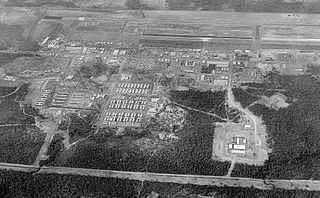
The Nakhon Phanom Royal Thai Navy Base (NKP), formerly Nakhon Phanom Royal Thai Air Force Base, is a Royal Thai Navy facility used for riverine patrols along the Mekong River. It is approximately 587 km (365 mi) northeast of Bangkok, 14.5 km (9.0 mi) west of Nakhon Phanom city in Nakhon Phanom Province in the northeastern region of Thailand, and 411 km (255 mi) from Hanoi in Vietnam. The Mekong River is NKP's border with Laos. The airfield at NKP is jointly used as a civilian airport.
Ubon Royal Thai Air Force Base is a Royal Thai Air Force (RTAF) facility located near the city of Ubon Ratchathani, in Ubon Ratchathani Province. It is approximately 488 km northeast of Bangkok. The Laos border is about 60 kilometres (37 mi) directly east. The facility is also used as a civil airport.

John Springer Walmsley Jr. was a bomber pilot in the United States Army Air Forces after World War II and the United States Air Force during the Korean War. Walmsley rose to the rank of captain and posthumously received the Medal of Honor for his heroic actions on September 14, 1951, above Yangdok, North Korea during a bombing mission.

The 502d Air Operations Group in an inactive United States Air Force unit. It was last active in October 2006 at Hickam Air Force Base, Hawaii, where it had served as the umbrella for intelligence and operational support units under Pacific Air Forces

The 421st Fighter Squadron is part of the 388th Fighter Wing at Hill Air Force Base, Utah. It operates the Lockheed Martin F-35A aircraft conducting air superiority missions. The squadron is one of the most decorated fighter squadrons in the United States Air Force, being awarded three Presidential Unit Citations and seven Air Force Outstanding Unit Awards for Valor in Combat.
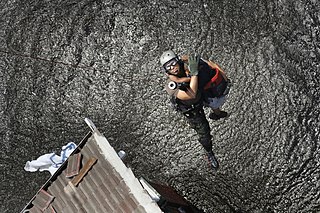
The 38th Rescue Squadron is an active United States Air Force Pararescue squadron. Part of the 347th Rescue Group, 23rd Wing, it is stationed at Moody Air Force Base, Georgia. The squadron flew combat search and rescue missions during the Korean War and the Vietnam War.

The Air Resupply And Communications Service (ARCS) is an inactive United States Air Force organization. It was assigned to Andrews Air Force Base, Maryland. Established during the Korean War, the mission of ARCS was providing the Air Force an unconventional warfare capability during the 1950s. It was inactivated in 1954, but elements continued to operate until the reactivation of air commando units by the Kennedy Administration in 1962.

The 581st Air Resupply and Communications Wing was a United States Air Force special operations wing, last assigned to Thirteenth Air Force at Clark Air Base, Philippines, from 1951-53.

The 563rd Rescue Group is a United States Air Force unit stationed at Davis-Monthan Air Force Base, Arizona. The group also controls the rescue squadrons at Nellis Air Force Base, Nevada. It is assigned to the 355th Wing. The group directs flying operations dedicated to personnel recovery and is part of Air Combat Command. The group was activated under its current designation at Davis-Monthan in 2003 to command rescue units in the western United States.
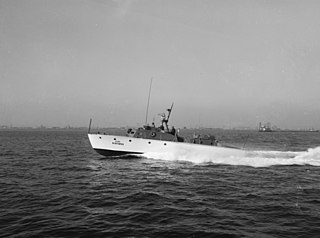
Crash Rescue Boat is a name used in the United States to describe military high-speed offshore rescue boats, similar in size and performance to motor torpedo boats, used to rescue pilots and aircrews of crashed aircraft. During World War II these rescue boats, armed with light anti-aircraft guns for self-defense, saw extensive service with the British Royal Air Force (RAF) and United States Army Air Forces (USAAF).

The 40th Helicopter Squadron is a missile support unit of the United States Air Force. As the 40th Aerospace Rescue and Recovery Squadron it was a helicopter rescue squadron of the USAF during the Vietnam War.
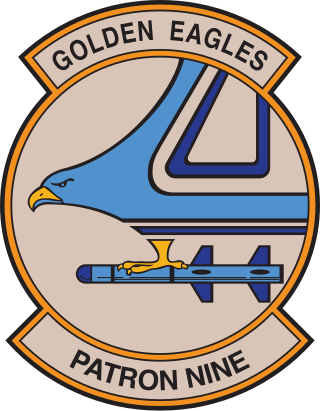
Patrol Squadron 9 (VP-9) is a U.S. Navy patrol squadron with its homeport located at Naval Air Station Whidbey Island. As of 2018, VP-9 is part of Patrol and Reconnaissance Wing Ten, Commander, Naval Air Forces, Pacific.

The 37th Helicopter Squadron is a United States Air Force unit assigned to the 582d Helicopter Group in support of the 90th Missile Wing located at Francis E. Warren Air Force Base, Wyoming. The unit is tasked with flight operations in support of the operation and security of F.E. Warren's intercontinental ballistic missile complex as well as search and rescue missions. The unit operates the UH-1N Huey helicopter.
The 6004th Air Intelligence Service Squadron was "the first covert collection agency in the history of the United States Air Force". Begun by Major Donald Nichols as an impromptu extension of his pre-Korean War espionage in 1950, it was first dubbed "Special Activities Unit Number One". In April or May 1951, it officially became the 6004th Air Intelligence Service Squadron. The 6004th was an unorthodox unit that engaged in espionage and aircrew escape and evasion, as well as collecting information. It was Far East Air Force's primary supplier of intelligence for the war, generating as many as 900 reports per month.
Donald Nichols was a United States Air Force intelligence officer who played a hidden but pivotal role in the Korean War. He and his spies found most of the North Korean targets destroyed by U.S. bombing during the war. Nichols also warned his superiors far in advance that North Korea was planning the surprise invasion that started the war, although his many warnings were ignored. In the first months of the war, Nichols and his men broke North Korean battle codes, which helped U.S. forces survive the invasion, halt the enemy's momentum, and destroy most of the North's army. Nichols created the Air Force's first covert intelligence unit, Detachment 2 of the 6004th Air Intelligence Service Squadron, which he commanded during most of the Korean War. His intelligence outfit, sometimes known as "Nick," saved American lives by going behind enemy lines to find vulnerabilities in Soviet tanks and MiG fighter jets. His intelligence achievements won him the Silver Star and the Distinguished Service Cross.
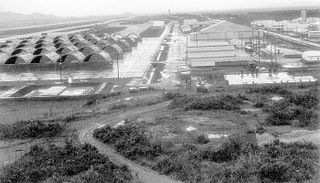
Phù Cát Air Base (1966–1975) was a United States Air Force (USAF) and Republic of Vietnam Air Force (RVNAF) facility used during the Vietnam War (1959–1975). It is located north of the city of Qui Nhơn in southern Vietnam.

[[]]

















